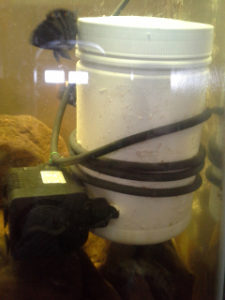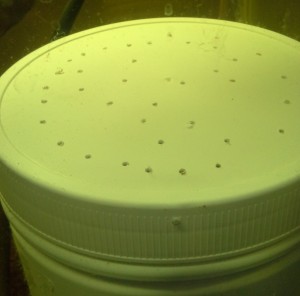DIY Aquarium Filter from Pond or Fountain Pump

In maintaining a 40 gallon aquarium, I find it maddening to have to keep buying filter packets for the standard aquarium filter that hangs on the back of the tank.
The filter pads need to be changed every couple of weeks and not only is this wasteful, but it is expensive.
To keep the tank clear, I find that one has to install a fresh filter packet at least once a month if not more often, and even on the aquarium page at Amazon, these costs can really add up.
Additionally, this is annoying because the entire filter unit has to be unplugged, carried to the sink dripping, and completely washed out because not only is the filter pack clogged, but so are the other internal parts.
Not only is this routine cleaning chore a messy hassle, but the biofilter inadvertently gets rinsed out as well (bad).
The biofilter is the black plastic sponge in which beneficial microbes are supposed to grow and live. It is this beneficial bacteria that keep the ammonia levels low for the health of the fish and also cut down on cloudy water.
The other annoying thing about the traditional filter system is that even after I clean it out and replace the filter pad, the system still does not do a very good job at filtering the tank.
I have always wished that I could build a better system to filter my tank.
Potential solutions to improving the filtration of an average sized home aquarium
In researching for this article, I came across the suggestion that I should an additional hang on the back filter (HOB filter); one for each side of the tank. To me, that would just double the hassle of maintaining the tank, and would double the maintenance cost.
I’m sure the filtration of the tank would improve, and I do notice that professional tanks set up in dentist offices, libraries and the like often have a HOB filter on each side of the tank.
Other ideas involved building canister-type filters in which the water is actually pumped out of the tank, filtered in a separate container, and then pumped back into the tank; kind of like kidney dialysis.
For me, I get nervous with the idea of pumping water out of my tank and into another container in my living room! I know that attempting one of these systems could spell disaster in countless ways, in terms of leaks, overflow risks, etc. I want to be able to go on vacation and not worry that I may be coming back to a flood. Also, I feel like my 40 gallon tank is not big enough to warrant such an endeavor.
Other, more promising, DIY systems involved using a powerhead and some sort of a container filled with various filter medium. The container is submerged into the tank, and the power head sucks water through one end of the filter canister and pushes clean water out of the other end.
This submersible filtration system is what I am after, except I do not have a power head, which is a specialized aquarium pump that has one nozzle that sucks in water and another that pushes water out. Also, powerheads are nice but can be expensive, although the one I linked to is pretty cheap and high quality.
Solution
My solution was to tweak the submersible filter designs to incorporate the use of a small pond/fountain pump. I happen to have one of these, and even if I did not, they can be found for a pretty low price as can be seen in the link.
A nice thing about using a pond/fountain pump is that they can also be used in aquaponics as well as in pond or fountain making, whereas a powerhead is only for aquarium water circulation.
Directions to build a submersible DIY aquarium filter using a pond or fountain pump:
Get a hard plastic container with a screw top lid. I used a whey protein container like this:

The next step is to drill small holes in the lid, like this:

Then cut a hole near the bottom of the container for the nozzle of your fountain pump to fit into. I used a nail to punch a hole in the filter canister and then a knife to make the hole big enough to push the pump into, as shown below.

A hole saw kit for a drill would have come in handy but at the time I did not have one with a small enough bit.
There is no need to seal the connection between the pump and canister as long as it fits snugly and will not come out during use.
You could seal it with silicone, but I like it not to be sealed so that I can easily remove the pump when I want to clean out the canister. You can also clean out the inside of the pump (fountain/pond pumps have a removable casing).
That’s it! Now all you have to do is fill the container up with a filter medium. For this, I used 100% polyester fiberfill (aka pillow stuffing). You can get a big bag of this for about $5 at a big box store or craft store. The $6 bag I purchased is enough to last me five years.
Line the bottom few inches of the container with rinsed gravel or small rocks from your yard, and stuff the fiberfill in next. The gravel helps to weigh the container down; otherwise it will float.
Note on Filter medium
Check out the aquarium page on Amazon (link above) to find a whole host of various filter medium. Some people have suggested adding in activated carbon, which would provide even more filtering capability than using just the fiber fill and gravel.
There are all kinds of other fascinating filter media that can be purchased and used in the submersible filter canister. I like to use stuff that can be washed and reused.
Place the filter into the tank and turn on the pump
I have found that placing the filter canister and pump on an elevated surface works the best. Position it on top of rocks, a brick, or whatever works best in your tank.
The Result
I can say that the filter works wonderfully. In 20 minutes, my tank was clear. The water is getting much more circulation as well, which is good for the tank environment. The pump does not make any noise (or at least much less than the old store bought filter did).
UPDATE: After a year of use, the filter system has worked beautifully. When the flow of water starts to slow down, as it ultimately will because the filter medium is collecting waste and doing its job, remove the canister and rinse out all of the components and you are back in business.
The only thing that I modified was the lid. I screwed the lid on and then secured it with 4 small wood screws because the lid had a tendency to pop off while in use. The screws can be easily removed for cleaning and then put back in to the same holes. I also punched some more holes in the top of the lid.
How it Works
The fountain pump sucks debris-filled water right through its intake openings and pushes it into the canister. The water has nowhere to go but up through the fiberfill ( or filter medium of your choice) and out through the holes in the lid.
The flow rate can be controlled by the regulator knob on the pump. But make sure that you buy a pump that is suitable for the size tank that you have (bigger is not better in this case).
The nice thing about this little system is that when the tank starts to look dirty, just remove the canister, open the lid, and wash out the fiber fill (maybe rinse the gravel too).
I am cleaning this new filter out a lot less frequently because there is about ten times the amount of filter media in the canister than what was in my hang on the back filter. So not only is this system sustainable and cheap, but it is also way more powerful and effective.
There is something quite satisfying about cleaning this filter set-up because you see all of the waste that was filtered out and you also have the satisfaction of knowing that you are reusing materials and saving money.
I plan to leave my hang on the back filter in place and designate it as strictly a biofilter. Since the water is being cleaned by my new filter, I should never have to clean out my hang on the back filter (or at least very rarely), so the beneficial microbes can be left undisturbed. And I definitely won’t be buying any more expensive and wasteful filter pads!
UPDATE: After a few months, my store bought HOB filter that I was using just as a bio filter burned out, and I tossed it into the trash for good. For a bio filter, I added a cut-up sponge and some gravel into a small plastic bottle with holes punched into it. I ran the air hose into the bottle opening and turned it on. I let the bottle sink to the bottom of the tank. The air pump sends the air through the opening of the bottle, through the gravel and sponge, and out through the holes in the bottle. This is where the beneficial microbes live now.
Water changes
Another thing that really helps the quality of the aquarium water is frequently changing out some of the water and adding new water. Here is how we do this using siphoning:
- Get a section of small hose about 3-4 feet long. Air hose works well for this, as does the size of hose that fits onto a standard pond pump.
- Submerge the entire hose into the tank, or fill it up with water from the sink (The hose needs to be full of water to start the siphoning process.)
- Pull one end of the hose out of the tank and into a bucket, out the window, whatever.
- The tank will drain as long as the end of the hose outside of the tank is lower than the hose on the inside of the tank.
Pro Tip: Water your plants or garden with the dirty fish tank water. If you do not have plants or a garden, check out the rest of our site and get up to speed! You are already producing plant food! (You can also grow plants right out of the top of the tank, but more on that another time.)
Please leave a comment if you have tried this or something similar. Thanks!!
Thanks for reading, and please share this article if you found it helpful.